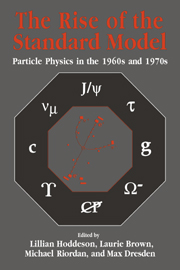Book contents
- Frontmatter
- Contents
- Contributors
- Editors' Acknowledgments
- Photographs of the Symposium
- Abbreviations and Acronyms
- Mathematical Notation
- Part One Introduction
- Part Two Quarks and Leptons
- Part Three Toward Gauge Theories
- Part Four Accelerators, Detectors, and Laboratories
- Part Five Electroweak Unification
- Part Six The Discovery of Quarks and Gluons
- 29 Early Baryon and Meson Spectroscopy Culminating in the Discovery of the Omega-Minus and Charmed Baryons
- 30 Quark Models and Quark Phenomenology
- 31 From the Nonrelativistic Quark Model to QCD and Back
- 32 Deep-Inelastic Scattering and the Discovery of Quarks
- 33 Deep-Inelastic Scattering: From Current Algebra to Partons
- 34 Hadron Jets and the Discovery of the Gluon
- Part Seven Personal Overviews
- Index
30 - Quark Models and Quark Phenomenology
Published online by Cambridge University Press: 03 February 2010
- Frontmatter
- Contents
- Contributors
- Editors' Acknowledgments
- Photographs of the Symposium
- Abbreviations and Acronyms
- Mathematical Notation
- Part One Introduction
- Part Two Quarks and Leptons
- Part Three Toward Gauge Theories
- Part Four Accelerators, Detectors, and Laboratories
- Part Five Electroweak Unification
- Part Six The Discovery of Quarks and Gluons
- 29 Early Baryon and Meson Spectroscopy Culminating in the Discovery of the Omega-Minus and Charmed Baryons
- 30 Quark Models and Quark Phenomenology
- 31 From the Nonrelativistic Quark Model to QCD and Back
- 32 Deep-Inelastic Scattering and the Discovery of Quarks
- 33 Deep-Inelastic Scattering: From Current Algebra to Partons
- 34 Hadron Jets and the Discovery of the Gluon
- Part Seven Personal Overviews
- Index
Summary
I begin with a tribute to a great physicist who taught me how to think about quarks and physics in general, John Bardeen. A few sentences from John could often teach you more and give more deep insight than ten hours of lectures from almost anyone else. In 1966 when I began to take quarks seriously, I was unknowingly thinking about them in the language I had learned from John during two years at the University of Illinois, as quasi-particle degrees of freedom describing the low-lying elementary excitations of hadronic matter. Unfortunately I did not realize how much my own thinking had been influenced by John Bardeen until he was gone. I dedicate this paper to his memory.
Were quarks real? Quarks as real as Cooper pairs would have been enough. Quarks leading to anything remotely approaching the exciting physics of the BCS theory would have been more than enough. John always emphasized that Cooper pairs were not bosons, and that super-conductivity was not Bose condensation. The physics was all in the difference between Cooper pairs and bosons. I was not disturbed when quarks did not behave according to the establishment criteria for particles. The physics might all be in the difference between quarks and normal particles. One had to explore the physics and see where the quark model led.
The arguments of the BCS critics that the theory was not gauge invariant did not disturb John; he knew where the right physics was.
- Type
- Chapter
- Information
- The Rise of the Standard ModelA History of Particle Physics from 1964 to 1979, pp. 542 - 560Publisher: Cambridge University PressPrint publication year: 1997
- 1
- Cited by



